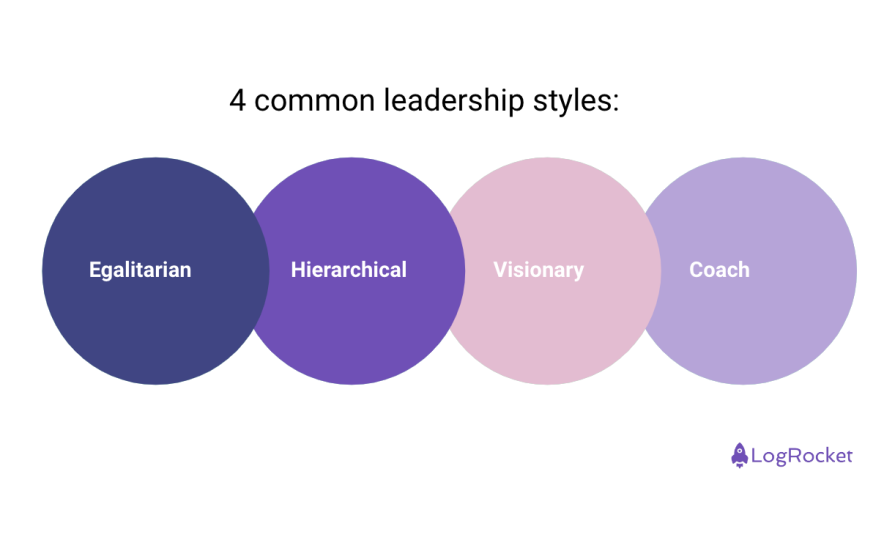What makes a great leader?

Answering this question is difficult because a lot of it depends on who you lead. What might be a successful leadership style in one place, may lead to considerable failures in others. This was one of the hardest things for me to understand when I started as a product manager.
I thought that once I developed a successful leadership style, I would easily be able to adapt it to new environments and team makeups. However, I soon realized that leadership styles are difficult to master and need to be flexible so that they can accommodate the needs of particular team members.
Teams are always in flux and PMs need to be prepared for change. Whether you feel you have a successful leadership style or not, everyone can benefit from reviewing their practices and assessing whether they’re working effectively.
In this article, you’ll learn what leadership styles are, the four most common styles, and how to tailor your leadership style to your team dynamics.
Leadership styles relate to how you collaborate with teams regarding decision-making, task delegation, communication, trust, and collaboration. The styles vary according to the following:
I used to think leadership could have a style that fits any team, but I was wrong. What works in one place may not work in another. Let’s understand common leadership styles.
Leadership is complex because the connection between people, tasks, desired outcomes, and multiple other variants is unpredictable. You won’t know the best alternatives upfront, which makes it challenging to be a great leader.
Let’s understand four common leadership styles and their difference:

What comes to your mind about an egalitarian leadership style?
You may have heard about flat hierarchies, consensual decision-making, and bi-directional feedback. All of these aspects are related to an egalitarian leadership style. Within this style, the leader is more like a function that creates an environment where great ideas can happen.
Egalitarian leaders don’t tell their teams what to do, they describe what to achieve. They don’t bother with how teams get things done, so much as how teams progress. Decisions are highly consensual, meaning that everyone weighs in with their perspective before the team commits to a direction.
This leadership style is prevalent in the Netherlands, Finland, Sweden, and Norway, among other countries.
What do you think about the hierarchical leadership style?
This style tends to be common for someone who makes decisions alone, tells the team what to do and how to do it, and holds teams accountable for meeting deadlines. You may perceive this as a negative, but it really depends on the context.
Hierarchical leaders shoulder responsibilities and want to ensure the best for their teams. They are often specialists and have more experience than the team members.
This leadership style is the opposite of an egalitarian. It’s a common approach in the BRIC countries — Brazil, Russia, India, and China.
Are you familiar with the idea of visionaries?
This leadership style is all about inspiring and motivating team members. The visionary can see what others don’t and gets teams excited about a promising future.
The visionary helps to remove distractions so the team can focus on the vision. Alongside this, they provide clear guidance on where to land and how to get there. However, a visionary can be pretty demanding when it comes to quality.
For example, Steve Jobs set higher standards for anything done at Apple. Some could get frustrated, but Jobs ensured Apple wouldn’t compromise on the vision.
Visionaries won’t accept “good enough” easily and they’ll push for the perfect solution.
Some leaders have a talent to transform a group of people into an outstanding team. They master the art of fostering collaboration and unlocking growth. I call these types of leaders coaches.
The coach doesn’t put themself in the spotlight, but works to get the team there. To accomplish this, the coach is a great observer and listener, allowing improvements to be made gradually. Coaches speak less than any team member and they ask more questions than they give answers.
This leadership style focuses on the team to help them grow. It trusts that a better team will be able to transform mediocre ideas into great ones and believes that great teams can develop game-changing ideas.
Think about the trillion-dollar coach Bill Campbell, who coached executives all over Silicon Valley, including Steve Jobs, Larry Page, Eric Schmidt, Jack Dorsey, and many others. He never took the spotlight because he wanted others to shine.
To get a better sense of your own leadership style, reflect on the following questions:
Use the above to understand your leadership style, but be aware that we all have a mixture of characteristics. There’s no right or wrong. There’s the context that requires different styles, learning about yourself, and increasing your leadership repertoire.
It’s becoming increasingly common to have teams spread worldwide, or even multicultural teams. Understanding your style is the first step; then, you need to understand what your team needs from you. For example, a team in the Netherlands will have a different way of working than a team from China. If you’re the leader, it’s your responsibility to uncover how your team ticks.
Make it simple for your team members. Strive to learn from them. Here are some questions you can ask them and learn how they tick:
Learning from your team is fundamental to crafting your leadership style. Once you have, you can make it transparent to everyone around you to avoid confusion. If you leave your style unspoken, you may get people talking behind your back because they don’t understand you.
Leading is complex because you have a direct impact on people’s lives.
Remember that there’s no such thing as one-size-fits-all leadership style. Because of this, you need to understand your own style and how it relates to the needs of your team. The best leaders are flexible and strive to understand the dynamics of their teams.
Do your best to listen and learn what your team members need from you. As a final thought, leadership is an active process, not something that you come to a definitive understanding of. Throughout your career you’ll develop your skills, but learning never stops! Adopting a growth mindset will serve you well as you engage with your team now and in the future.
Featured image source: IconScout

LogRocket identifies friction points in the user experience so you can make informed decisions about product and design changes that must happen to hit your goals.
With LogRocket, you can understand the scope of the issues affecting your product and prioritize the changes that need to be made. LogRocket simplifies workflows by allowing Engineering, Product, UX, and Design teams to work from the same data as you, eliminating any confusion about what needs to be done.
Get your teams on the same page — try LogRocket today.

Most teams fail at autonomy. Learn how clear rules help product teams move faster without micromanagement.

A practical framework for PMs to use AI in ideation without sacrificing judgment, strategy, or decision quality.

A practical five minute revenue estimation method to help product managers compare ideas, drop low impact features, and prioritize smarter.

A practical guide for PMs who want to stop being bottlenecks, delegate smarter, and lead teams effectively with a clear ownership framework.